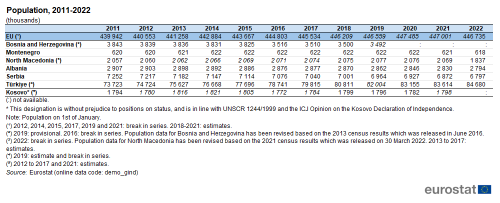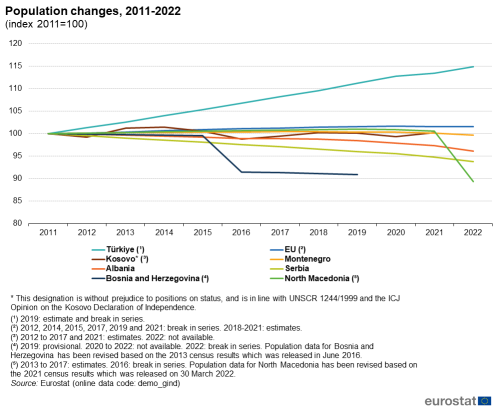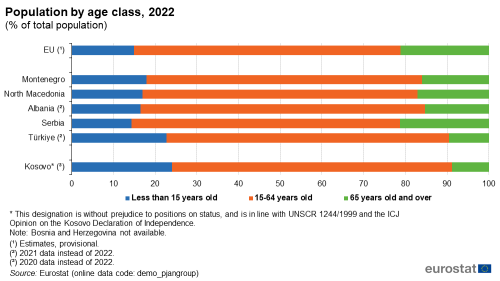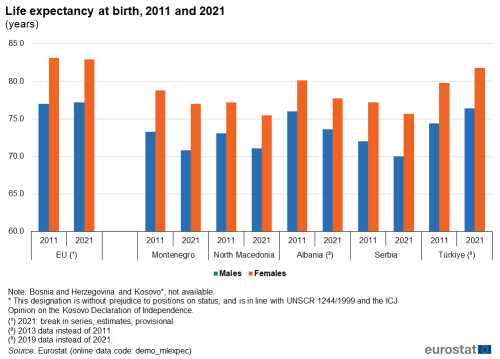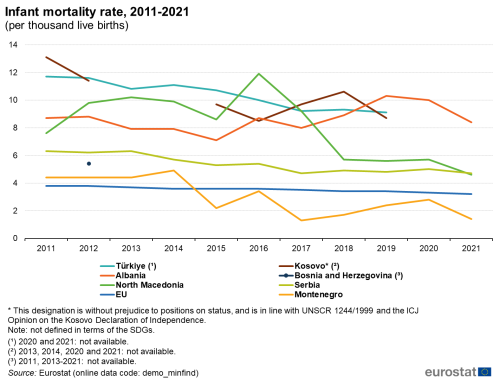Enlargement countries - population statistics
Data extracted in May 2023.
Planned article update: May 2024.
Highlights
In 2022, the combined population of the Western Balkans and Türkiye was equivalent to 22.8 % of the EU population.
Among the Western Balkans and Türkiye, the highest shares of young people were in Kosovo (24.0 %; 2020 data) and Türkiye (22.8 %; 2021), while the lowest share was in Serbia (14.3 %; 2022).
In 2021, Montenegro had the highest fertility rate among the Western Balkans and Türkiye, at 1.76 children per woman, while Albania had the lowest rate, at 1.31 children per woman. EU’s fertility rate in 2021 stood at 1.53 children per woman.
In 2021, among the Western Balkans and Türkiye, Bosnia and Herzegovina (8.4 per thousand inhabitants) and Serbia (9.1) were the only countries to record crude birth rates that were lower than or equal to the EU rate (9.1).
Population changes, 2011-2022
This article is part of an online publication and provides information on a range of population statistics for the Western Balkans and Türkiye and compares this with the corresponding data for the European Union (EU). Within this region, Bosnia and Herzegovina, Montenegro, North Macedonia, Albania, Serbia and Türkiye are candidate countries, while Kosovo* has the status of potential candidate.
Data for Georgia, Moldova and Ukraine, granted candidate status or European perspective by the European Council in June 2022, are not included in this article; Statistics Explained articles on the European Neighbourhood Policy-East countries are available here.
The article gives an overview of demographic developments in the Western Balkans and Türkiye, presenting indicators such as the total population, crude birth and death rates, fertility rates, life expectancy and the infant mortality rate.
*This designation is without prejudice to positions on status, and is in line with UNSCR 1244/1999 and the ICJ Opinion on the Kosovo Declaration of Independence.
Full article
Population and age structure
The recommended definition of total population is the ‘usual resident population’, which represents the number of inhabitants of a given area. Eurostat uses the reference date of 1 January of the year in question. In some cases, the 31 December of the previous year is used.
The combined population of the Western Balkans and Türkiye was estimated to be 102.0 million inhabitants in 2022, which was between one fifth and one quarter, 22.8 %, of the size of the total EU population (Table 1). Türkiye was by far the most populous of the group, with 84.7 million inhabitants in 2022. Montenegro had the smallest population, with somewhat over 618 thousand inhabitants.
In total, there were 446.7 million persons resident in the European Union as of 1 January 2022.
Population changes among the Western Balkans and Türkiye followed varied patterns during the period 2011-2022 (Figure 1). The population of Türkiye increased at a relatively rapid pace, growing by 14.9 % overall during this period, an annual average of 1.27 %.
Montenegro’s population decreased by -0.3 % over 2011-2022, corresponding to an annual average decline of just -0.03 %. The population of Albania was also down over this period, by -3.9 %, averaging -0.4 % per year.
The Serbian population fell by -6.3 % between 2011 and 2022, corresponding to an annual average of -0.6 %. The number of residents in North Macedonia shrunk by -10.7 % over the period, at an annual average rate of -1.0 %.
Kosovo’s population statistics underwent a major break in the time series in 2011, following the population census that year. From 2011 to 2021 (the most recent data available), the population grew by 0.2 %, at an annual average of only 0.02 %.
Bosnia and Herzegovina’s population fell by 9.1 % over the period 2011 to 2019 (the latest available data), corresponding to an annual average decline of -1.1 %, although a large share of this fall was registered in 2016.
In the EU, the population grew by 1.5 % over 2011-2022, at an annual average of 0.1 %.
The working age population, defined as those aged 15-64 years, accounted for 64.4 % of the total population in Serbia in 2022, the lowest share among Western Balkans and Türkiye. The highest share was 67.7 % in Türkiye. Data is not available for Bosnia and Herzegovina. Working age people accounted for less than two thirds, 63.9 %, of the total population in the EU in 2022.
Those aged less than 15 years accounted for 14.3 % of the total population in Serbia in 2022; 16.5 % in Albania, 17.0 % in North Macedonia and 17.9 % in Montenegro. The share of this age group was closer to one quarter of the total population in Türkiye, at 22.8 %; and in Kosovo, at 24.0 % (2020 data). Conversely, less than one tenth of the total population in both Kosovo (2020 data) and Türkiye were aged 65 years and over, while this share was 21.1 % in the EU and 21.3 % in Serbia, the latter having the highest share among the Western Balkans and Türkiye.
Birth and death rates
The crude rate of natural increase is calculated by subtracting the crude death rate from the crude birth rate. A positive result implies that the natural rate of population change (in other words, excluding the effects of migrant flows) is positive and so the population increases. The data are illustrated in Figure 3.
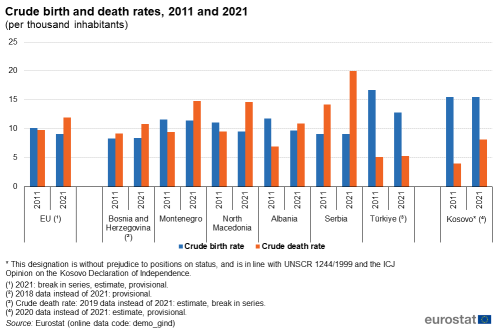
(per thousand inhabitants)
Source: Eurostat (demo_gind)
In 2021, Türkiye recorded a crude birth rate of 12.8 per thousand inhabitants; in 2011, the crude birth rate stood at 16.7. For the crude death rate, the most recent data available for Türkiye refers to 2019, when the rate was 5.3, slightly higher than the 5.1 recorded in 2011. Thus, the crude rate of natural population increase for Türkiye declined from 11.6 per thousand inhabitants in 2011 to an estimated 7.5 in 2021 (using the crude death rate for 2019), decreasing by -4.1 between these years. Kosovo also recorded a positive natural population increase in both 2011 and 2020 (the most recent data available), at 11.5 and 7.4 per thousand inhabitants, respectively. The natural population increase thus slowed down by -4.1 over the period, due to a corresponding rise in the crude death rate from 4.0 in 2011 to 8.1 in 2020. The crude birth date stayed at 15.5 births per thousand inhabitants in both years.
In contrast, Bosnia and Herzegovina (2018 data), Montenegro, North Macedonia, Albania and Serbia all reported higher crude death rates than crude birth rates in 2021, resulting in a natural population decrease. For Bosnia and Herzegovina, the natural population decrease was -2.4 per thousand inhabitants in 2018 (more recent data not available), down from a natural decrease of -0.9 in 2011. For most of the other countries, the natural population growth changed from an increase in 2011 to a decrease in 2021, mainly caused by sharp increases in the crude death rates. The Covid-19 pandemic may have influenced the high 2021 crude death rates. For Montenegro, the natural population decrease stood at -3.4 per thousand inhabitants in 2021, compared to a natural increase of 2.2 in 2011; for North Macedonia, the natural decrease was -5.1 in 2021, compared to an increase of 1.6 in 2011; for Albania, the natural population decrease was -1.2 in 2021, down from an increase of 4.9 in 2011.
Serbia recorded by far the largest natural population decrease among the Western Balkans and Türkiye in 2021, with a population decrease at -10.9 per thousand inhabitants. This was mainly caused by a crude death rate of 20.0 in 2021, down from 14.2 in 2011, while the crude birth rate was unchanged at 9.1.
In the EU, the crude birth rate was higher than the crude death rate in 2011, resulting in a natural population increase of 0.3 per thousand inhabitants that year. However, since 2012 the death rate has consistently exceeded the birth rate, yielding a slight natural population decrease each year. It is noticeable that the crude death rate was somewhat higher in 2020 and 2021 than in previous years, possibly due to the Covid-19 pandemic. In 2021, the natural decrease in the EU population was -2.8 per thousand inhabitants.
Fertility rates
The total fertility rate is defined as the mean number of children who would be born to a woman during her lifetime, if she were to spend her childbearing years conforming to the age-specific fertility rates that have been measured in a given year. The data are illustrated by Figure 4.
Among the Western Balkans and Türkiye, Türkiye recorded fertility rates closest to the replacement level of around 2.06 children per woman. Türkiye’s fertility rate was 2.03 children per woman in 2011 and remained in the range 2.03 - 2.17 during the period 2011-2017. The fertility rate fell to 1.99 in 2018 and further to 1.88 in 2019 (the most recent data available).
In Montenegro, fertility was 1.65 children per woman in 2011. Thereafter, the fertility rate has stayed in the range 1.72 - 1.79 children per woman, most recently 1.76 in 2021. Fertility in Serbia was in the range 1.40 - 1.52 children per woman throughout the period 2011-2021, rising from 1.40 in 2011 to peaks at 1.52 in 2019 and 2021. In North Macedonia, the number of children per woman generally lay between 1.46 and 1.52 in the period 2011-2016. The fertility rate subsequently fell to 1.43 in 2017 and 1.42 in 2018, before falling further to 1.34 in 2019 and 1.31 in 2020. However, fertility picked up again to reach 1.44 in 2021.
In Albania, fertility increased from 1.65 children per woman in 2011 to 1.73 in both 2013 and 2014, before falling consistently to 1.31 in 2021 (data for 2019 not available). Kosovo’s short time series reported a fertility rate of 1.66 children per woman in 2016, falling to 1.55 in 2019. Data is not available for Bosnia and Herzegovina.
The fertility rate in the EU was relatively stable over the period 2011-2021, standing at 1.54 in 2011 and 1.53 in 2021, staying within 1.50 - 1.57 throughout the period.

(average number of children per woman)
Source: Eurostat (demo_find)alt= a line chart with seven lines showing total fertility rate in 2011 to 20212021 the lines show Albania, Türkiye, Kosovo, Montenegro, Serbia, North Macedonia and the EU.
The increasing average age of women at childbirth is a global phenomenon. The Western Balkans and Türkiye are no exceptions. Between 2011 and 2021, the mean age of women at childbirth increased by 1.3 years to 30.0 years old in Montenegro, by 1.1 years to 29.5 in Serbia, by 1.8 years to 29.2 in Albania, by 1.1 years to 29.0 (2020 data) in Türkiye, and by 0.8 years to 28.8 in North Macedonia (Figure 5). In Kosovo, the average age of women at childbirth was 29.8 years old in 2019 (the most recent data available); data for 2011 are not available. In the EU, the average age of women at childbirth was 30.2 years old in 2011 and estimated at 31.1 in 2021, an increase by 1.1 years.

(years)
Source: Eurostat (demo_find)alt= A double horizontal bar chart showing the mean age of women at childbirth in 2011 and 2021 in Albania, Türkiye, Kosovo, Montenegro, Serbia, North Macedonia and the EU.
Life expectancy
Life expectancy at a certain age is the mean additional number of years that a person of that age can expect to live, if subjected throughout the rest of his or her life to the current mortality conditions. Life expectancy at birth has risen rapidly over the last century in most of the world due to advances in healthcare and medicine, linked especially to reduced infant mortality, as well as rising living standards, improved lifestyles and better education.
There were decreases in life expectancy between 2011 and 2021 for both men and women among the Western Balkans, although not in Türkiye. Figure 6 illustrates the data. Life expectancy at birth in Türkiye rose for both men and women from 2011 to 2019 (2020 and 2021 data not available): the life expectancy of men increased by 2.0 years from 74.4 years in 2011 to 76.4 in 2019; that of women also increased by 2.0 years over this period, from 79.8 to 81.8.
The strongest decrease in life expectancy over 2011-2021 was registered in Montenegro, where the life expectancy of men decreased by 2.5 years from 73.3 to 70.8, while life expectancy for women decreased by 1.8 years from 78.8 to 77.0. Albania also experienced substantially falling life expectancies between 2013 (2011 and 2012 data not available) and 2021, decreasing by 2.4 years for both men and women. Life expectancy in Albania fell from 76.0 in 2013 to 73.6 in 2021 for men and from 80.1 to 77.7 for women. North Macedonia and Serbia experienced intermediate decreases in life expectancy over 2011-2021. In North Macedonia, men had a life expectancy of 73.1 years in 2011 and 71.1 ten years later, a decrease of 2.0 years; the corresponding figures for women were 77.2 and 75.5 with a decrease of 1.7 years. In Serbia male life expectancy decreased from 72.0 to 70.0 (-2.0 years) over the period; female life expectancy went down from 77.2 to 75.7 (-1.5 years). Data were not available for Bosnia and Herzegovina and Kosovo. In comparison, the life expectancy for men in the EU increased slightly, by 0.2 years, from 77.0 in 2011 to 77.2 in 2021. For women, life expectancy in the EU decreased by -0.2 years from 83.1 in 2011 to 82.9 in 2021.
Life expectancy at birth is higher for women than for men both within the EU and throughout the Western Balkans and Türkiye (for those for which data are available) (Figure 6). In 2021, the gender gap in life expectancy was 6.2 years in Montenegro, 5.7 in Serbia, 5.4 in Türkiye (2019 data), 4.4 in North Macedonia, and 4.1 in Albania. In the EU, the life expectancy gender gap was 5.7 years in 2021, down from 6.1 years in 2011.
In 2021, life expectancy for men among the Western Balkans and Türkiye ranged from 70.8 to 76.4 years (a difference of 5.6 years). For women, life expectancy in 2021 among the Western Balkans and Türkiye was slightly less homogeneous, ranging from 75.5 to 81.8 years, a difference of 6.3 years.
Infant mortality rates
The infant mortality rate is defined as the ratio of the number of deaths of children under one year of age to the number of live births in the reference year; the value is expressed per thousand live births.
Infant mortality rates fell in most of the Western Balkans and Türkiye in recent years (Figure 7); in some, this decrease has been rapid. In Kosovo, infant mortality was 13.1 per thousand live births in 2011, falling to 8.7 in 2019 (the most recent data available), a decrease by -4.4. In Montenegro, the infant mortality rate fell from 4.4 in 2011 to 1.4 in 2021, a decrease of -3.0, below the level in the EU. In North Macedonia, infant mortality rate was 7.6 in 2011. Regardless of increases between 2012 and 2016, it declined to 4.6 in 2021, also representing a fall by -3.0. Türkiye also experienced a substantial decline of -2.6 in infant mortality, from 11.7 in 2011 to 9.1 in 2019 (the most recent data available). In Serbia, the rate fell from 6.3 to 4.7 over the period 2011-2021, while that in Albania declined from 8.7 to 8.4 (-0.3). For Bosnia and Herzegovina, data is only available for 2012 (at 5.4 per thousand live deaths), so disabling analysis of trends over time.
In the EU, infant mortality declined from 3.8 per thousand live births in 2011 to 3.2 in 2021, a decrease by 0.6.
Source data for tables and figures (MS Excel)
Data sources
Data for the enlargement countries are collected for a wide range of indicators each year through a questionnaire that is sent by Eurostat to Western Balkans and Türkiye. A network of contacts has been established for updating these questionnaires, generally within the national statistical offices, but potentially including representatives of other data-producing organisations, for example, central banks or government ministries.
Since 2016, the Western Balkans and Türkiye provide population data directly to Eurostat’s unit responsible for population and migration statistics; these data have been used in this article. This mechanism operates in the same way as Eurostat’s regular collection of population data from EU Member States and EFTA countries. These statistics are available free-of-charge on Eurostat’s website.
Eurostat provides a wide range of demographic data, including statistics on populations at national and regional level, as well as for various demographic factors influencing the size, the structure and the specific characteristics of these populations.
Population data for Bosnia and Herzegovina has been revised based on the 2013 census results which was released in June 2016. A break appears in the time series as the revision has not been done backwards.
Population data for North Macedonia has been revised based on the 2021 census results which was released on 30 March 2022. A break appears in the time series as the revision has not been done backwards.
Tables in this article use the following notation:
| Value in italics | data value is forecasted, provisional or estimated and is therefore likely to change; |
| : | not available, confidential or unreliable value. |
Context
Population statistics are widely used to compare statistics relating to regions or countries that are inevitably of different sizes. Population is used as the denominator to normalise these data to a per person (per capita) basis. Examples include government expenditure per person between regions; hospital beds per thousand population; school places per thousand children within a specific age range. Population statistics are used both in policy development and in discussion of its outcomes.
Population statistics are the basis for distributing seats in democratic assemblies, where these are allocated geographically.
Population statistics are also used in business decisions, both at local level and in focussing on specific age ranges.
These statistics are used to analyse population ageing and its effects on the labour force and the age dependency ratio, so informing social and employment policies.
Information concerning the current statistical legislation on population and demography statistics can be found here:
While basic principles and institutional frameworks for producing statistics are already in place, the Western Balkans and Türkiye are expected to increase progressively the volume and quality of their data and to transmit these data to Eurostat in the context of the EU enlargement process. EU standards in the field of statistics require the existence of a statistical infrastructure based on principles such as professional independence, impartiality, relevance, confidentiality of individual data and easy access to official statistics; they cover methodology, classifications and standards for production.
Eurostat has the responsibility to monitor that statistical production of the Western Balkans and Türkiye complies with the EU acquis in the field of statistics. To do so, Eurostat supports the national statistical offices and other producers of official statistics through a range of initiatives, such as pilot surveys, training courses, traineeships, study visits, workshops and seminars, and participation in meetings within the European Statistical System (ESS). The ultimate goal is the provision of harmonised, high-quality data that conforms to European and international standards.
Additional information on statistical cooperation with the enlargement countries is provided here.
Direct access to
See also
- Enlargement countries — statistical overview — online publication
- Statistical cooperation — online publication
- Population and demography
- Population and population change statistics
- Population structure and ageing
Publications
- Statistical books/pocketbooks
- Key figures on enlargement countries — 2019 edition
- Key figures on enlargement countries — 2017 edition
- Key figures on the enlargement countries — 2014 edition
- Factsheets
- Basic figures on the candidate countries and potential candidates — Factsheets — 2023 edition
- Basic figures on Western Balkans and Türkiye — Factsheets — 2022 edition
- Basic figures on enlargement countries — Factsheets — 2021 edition
- Leaflets
- Basic figures on enlargement countries — 2020 edition
- Basic figures on enlargement countries — 2019 edition
- Basic figures on enlargement countries — 2018 edition
- Basic figures on enlargement countries — 2016 edition
- Enlargement countries — Demographic statistics — 2015 edition
- Key figures on the enlargement countries — Population and social conditions — 2013 edition
Database
- Population change - Demographic balance and crude rates at national level (demo_gind)
- Population (demo_pop)
- Fertility (demo_fer)
- Mortality (demo_mor)
Dedicated section
Methodology / Metadata
- Population change - Demographic balance and crude rates at national level (ESMS metadata file — demo_gind_esms)
- Population (ESMS metadata file — demo_pop_esms)
- Fertility (ESMS metadata file — demo_fer_esms)
- Mortality (ESMS metadata file — demo_mor_esms)
